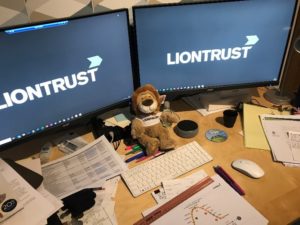How has the coronavirus affected your day-to-day work?
In terms of running our portfolio, remote working for fund managers has been a tried-and-tested approach over the 20 years since Liontrust was founded. It’s a process-driven house and fund managers have always been given the flexibility to work in the best possible environment for them to be successful – and this has always included the ability to work from home.
For me personally – outside of these extraordinary times – I can spend a couple of days of my week visiting my clients around the UK, from Cornwall to Scotland. This has now changed to a series of video or conference calls, and we have also used webinars to communicate with investors.
 What has been your biggest contributor to performance since the coronavirus hit markets? What has been your biggest detractor?
What has been your biggest contributor to performance since the coronavirus hit markets? What has been your biggest detractor?
We manage a range of target risk managed portfolios, which have performed as expected in falling markets, with the lower-risk portfolios preserving the most capital as they have higher weightings to defensive assets, including government bonds and cash.
Do you have any behavioural mechanisms in place for navigating the market volatility?
Our focus is on patient investing – what we call ‘winning by not losing’ – and what this requires is the ability to look through short-term periods and keep faith in the long-term investment process.
Over a market cycle, our mechanism for controlling emotion is our tactical asset allocation scoring, which ranges from one to five – with one being the most bearish on markets and five the most positive. While we have been scoring three since October 2018, the speed of recent events meant we were unable to dial down the risk further. However, current positioning gives us plenty of scope to take advantage of increasingly cheap equity valuations as we look forward, increasing risk as we move up to five.
What has surprised you most about markets during the coronavirus sell-off?
The speed of the decline was a surprise to most market participants – 13 trading days to enter a bear market (-20%), which was more than likely driven by quant-type strategies. I remember back to October 1987, however, when the markets plunged on Black Monday and by the end of the following trading day it was a bear market.
What feedback have you had from clients since the sell-off?
We have been in regular communication with our advisers since the sell-off with a clear message that we are here to support them and their clients. The advisers who outsource their investment decisions to us through target risk portfolios, are seeking reassurance. Much of this reassurance has been seen in the returns of the portfolios which have performed in line with expectations. We are writing regular commentary to support the advisers’ communication to their clients as well as webinars and articles.
What are the key messages you want to hear from your holdings at the moment?
We are in close contact with our underlying fund managers and we are comforted – as odd as it might sound – that most are currently doing nothing in terms of buying and selling.
We want to see the managers continuing to stick to their investment processes. All our fund managers are selected on the basis they are patient investors and have successfully kept to a certain style over the long term so any sudden shifts in approach would raise a red flag. What we are seeing them do is forensically revisiting their portfolios, to ensure the case for each stock over the long term remains intact and we would expect many to take advantage of cheap valuations in the months ahead.
How does this compare to other market sell-offs you have managed money through?
This is the fourth bear market of my career and, while the catalysts are always different, there are clear similarities and we expect to see a recovery this time as well – although, like everyone else, I cannot say exactly when that will be.
So far, markets have treated the pandemic as a classic growth shock and reacted in typical bear fashion: the difference to the two previous declines has been the speed, with the slowest bull run in history quickly giving way to one of the rapidest bear markets.
Amid huge daily declines in stockmarkets, we have seen emergency policy responses from central banks in cutting interest rates to record lows and providing much-needed liquidity and lines of credit, with none of the moral hazard concerns that muddied the situation around banks in 2008. With many businesses threatened as countries enter lockdown periods, we would expect much more of this to come.
Looking to the next few weeks and months, there remains a huge amount of uncertainty and it is imperative we avoid the panic that has overtaken markets. Without being flippant, this is not the end of the world and things will recover – market participants are currently attempting to bridge the gap between perception and reality when it comes to the ultimate impact on growth and that will lead to abundant debate over ‘U’ versus ‘V’-shaped recoveries, and the alphabet soup beyond that.
It is always useful to put dramatic, short-term events into a long-term perspective: over Monday 19 October and Tuesday 20 October 1987, for example, the FTSE 100 fell 23% as Black Monday hit, but over the subsequent five years it produced a total return of 74.8%. Bull markets ultimately last far longer than bear markets and these falls become mere blips on performance graphs the further back in history you go.
Another message to get across is that falling markets will always feel uncomfortable but a drawdown only becomes a loss when investors crystallise it by selling. Again, looking at history shows many of the worst days in markets are often followed by some of the best, and selling out means missing these recoveries.
If you take the FTSE 100 stretching back to 1984, there have only been nine negative years out of 36, meaning positive 12-month periods are four times more likely. The average annual maximum drawdown over the period is 14% but, in the majority of cases, the index ended that period in positive territory.
What previous bear markets have taught us is that staying calm is vital and not to get caught up in the fear and greed-inspired push and pull of volatile markets. No-one can control markets but we can control our own emotions – and when it comes to investment, this means falling back on a robust, consistent and repeatable investment process.
How do you find working remotely during volatile markets?
Given I previously spent a couple days a week working remotely, it’s not a huge challenge. If anything, it enables my co-manager Paul Kim and I not to get swallowed up by the noise and to stand back and focus on our own process.
What do you do for fun when you take a break from working at home?
This is the first major global crisis where social media will have a material impact on the behaviour of individuals, businesses and governments. It is also a channel for communicating with the wider world while stuck indoors and, as a family, we have been getting involved with some of the online challenges. Personally, for me this has been trying in the back garden to attempt the golfing tricks and hints posted by some of best tour professional golfers, such as Richard McEvoy.
What is your favourite snack when working from home?
I try very hard to avoid snacking at home but when my daughter has baked a banana cake that rule is quickly abandoned.
Do you have a ‘top tip’ to share on working remotely?
Having been working from home at least once a week for a number of years, my top tip is to find a routine that works and stick to it. For me, it is writing down a list the night before of the tasks I want to achieve the next day. For each task, I work out how long it will take and then plan my day accordingly, leaving time for a walk before lunch.
John Husselbee is head of multi-asset at Liontrust Asset Management










